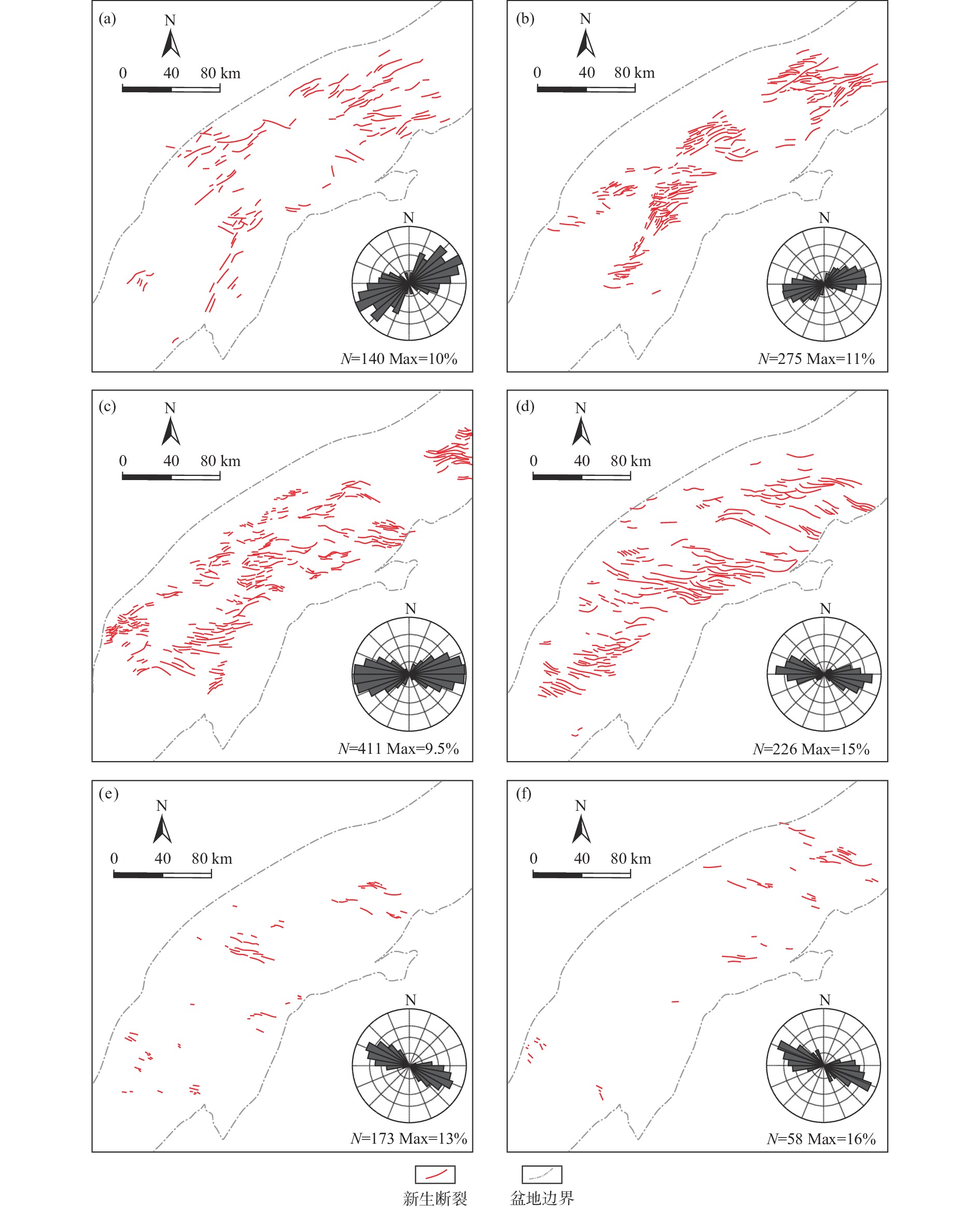Control of the Cenozoic transformation in regional extension direction on the development and evolution of fault system in Zhusan Depression
-
摘要: 沉积盆地内断裂体系的复杂性与多样性及其形成演化机制长期以来备受关注。以南海北部陆缘珠三坳陷为研究目标,在大量三维地震资料构造解析的基础上,分析了新生代区域伸展方向的转变规律,探讨了其对断裂体系发育演化的控制作用。研究结果表明:珠三坳陷断裂具有多走向、多级别、多性质的特点,依据断裂走向可以划分为NNE-NE、NWW-NW和近EW向3组,不同走向断裂发育特征、断裂性质及分布规律存在差异。新生代珠三坳陷区域伸展方向经历了顺时针旋转的演化,由古新—中始新世神狐-文昌组沉积期的NW—SE向,转变为晚始新—早中新世恩平-珠江组沉积期的近SN向,到中中新世韩江组沉积期至今的NNE—SSW向。新生代区域伸展方向的转变与先存断裂共同控制了珠三断裂体系的发育演化,整体上导致各演化阶段活动断裂特征存在差异。从具体断裂上看主要表现在:古新—始新世强烈活动的南断裂带南支西段在中晚期消亡;南断裂带北支不同分段的断裂性质存在一定差异;走向弯曲的琼海1号、南断裂带北支文昌 B 凹北段晚期发生局部构造反转。以上几方面现象共同反映了新生代区域伸展方向转变对珠三坳陷断裂体系发育演化的控制作用。Abstract: The complexity and diversity of fault systems in sedimentary basins, as well as their formation and evolution mechanisms, have long been of great concern. Taking the Zhusan Depression on the northern margin of the South China Sea as the research objective, based on the structural analysis of a large amount of three-dimensional seismic data, the transformation in the direction of the Cenozoic regional extension was analyzed, and its role of control on the development and evolution of fault systems was explored. Results indicate that the faults in the Zhusan Depression have the characteristics of multiple strikes, levels, and properties. In fault strike, they could be divided into three groups: NNE-NE, NWW-NW, and near EW. There are differences in the development characteristics, properties, and distribution patterns of faults in different strike directions. The regional extension direction of Zhusan Depression experienced clockwise rotation evolution in the Cenozoic, from the NW-SE direction of the Paleocene-Eocene Shenhu Wenchang Formation sedimentary period, to the nearly SN direction of the Oligocene-Early Miocene Enping-Zhujiang Formation sedimentary period, and to the Middle Miocene Hanjiang Formation sedimentary period in NNE-SSW direction. The transformation of the direction of regional extension in the Cenozoic and the preexisting faults jointly controlled the development and evolution of the Pearl River Delta fault system, resulting in differences in the characteristics of active faults in different stages of evolution. This is mainly manifested in the disappearance of the southern branch of the western segment of the southern fault zone, which was strongly active during the Paleocene-Eocene in the middle and late stages. The fault properties of different segments of the northern branch of the southern fault zone are different. For example, the bending of Qionghai No.1 Fault and structural inversion in the northern section of Wenchang B Sag, reflect the control effect of direction change of the Cenozoic regional extension on development and evolution of fault system in the Zhusan Depression.
-
0. 引言
为研究裂陷盆地断裂系统的发育特征与形成演化,前人提出了Anderson模式、斜向伸展模式和叠加模式3种解释模式[1]。经典的Anderson模式作为断层力学分析的基础,在断层的分布特征、形成演化、定量研究等方面取得了一系列的重要成果[2-5],但是难以合理地解释裂陷盆地断层分布的复杂现象,也没有很好地揭示裂陷盆地断层复杂性的实质和断层形成演化的规律[6]。“斜向伸展”是指伸展方向与盆地边界基底先存断裂斜交的伸展作用,最早在研究多期伸展裂谷盆地时提出[7-8],主要用来描述裂谷盆地边界断层与伸展方向不垂直相交时的构造发育模式,该模型对裂陷盆地断层复杂性的研究取得了实质性进展,被广泛应用到裂陷盆地断裂系统的研究中[9-11]。“不协调伸展”是指基底存在不同方向先存构造基础上的伸展作用,能合理地解释裂陷盆地断层复杂性的各种表现形式[10]。无论斜向伸展还是不协调伸展作用模式,均强调区域伸展方向与先存构造之间的不垂直相交,其中,区域伸展方向是裂陷盆地构造变形的最主要的边界条件之一,同时也是决定断裂系统形成和演化的主导因素之一[10]。中国东部新生代盆地的形成演化主要受控于太平洋板块、印度板块与欧亚板块的相互作用,裂陷作用主要受控于太平洋板块的后撤式俯冲[12-14]。受太平洋板块俯冲方向变化的影响,中国东部区域伸展方向经历了由古新—始新世的NW向到渐新世至今近SN向的转变[10-11,13-17]。
作为发育在南海北缘的一个新生代断陷-拗陷型盆地,珠三坳陷经历了多期次构造运动的叠加改造,断裂体系、构造样式复杂多样。有学者认为新生代经历了上述2期伸展方向的转变[18],也有学者认为新生代区域伸展方向经历了NW—近SN—NNE向的转变,但对不同伸展方向阶段的划分存在争议[19-22]。本文基于珠三坳陷地质、地震及勘探成果资料,结合前人研究成果,在对断裂体系发育演化特征分析的基础上,系统总结了新生代珠三坳陷区域伸展方向的转变规律,探讨了区域伸展方向转变对珠三坳陷断裂体系发育演化的控制作用。本研究有助于进一步明确南海北缘盆地的成因演化机制,为研究区油气勘探提供支撑。
1. 区域地质概况
珠三坳陷所在的珠江口盆地位于南海北部大陆边缘,是在前古近系基底上发育的新生代断陷-拗陷型盆地。珠三坳陷位于珠江口盆地西部,北邻海南隆起,东接珠一坳陷,南接神狐隆起,其内部包含多个构造单元,构造走向以NE、NEE向为主,面积约3.6×104 km2(图1a、b)。断裂是珠三坳陷内最为重要的构造变形样式,具有数量多、类型丰富、样式复杂等特征,对坳陷的发育演化、地层沉积、油气生成、聚集成藏具有重要的控制作用[19-20,23-24]。
珠三坳陷新生代盆地基底为中生代岩浆岩和古生代变质岩[25-26],新生界自下而上可以划分为古近系神狐组、文昌组、恩平组、珠海组,新近系珠江组、韩江组、粤海组、万山组和第四系琼海组[19]。神狐组、文昌组、恩平组沉积期为陆相断陷湖泊充填期,沉积了一套河流、沼泽、湖泊相碎屑岩;珠海组沉积期湖泊逐渐消亡,从南向北发生了大规模的海侵,以半封闭浅海潮汐作用为主的砂泥岩沉积为主;珠江组沉积期以来,珠三坳陷转为海相沉积,以滨、浅海砂泥岩沉积为主,韩江组夹生物礁滩灰岩[19,21,24,27]。
构造演化方面,珠三坳陷位于华南板块陆缘,中生代经历了印支期华南板块与印支板块碰撞拼合、燕山期古太平洋板块向欧亚板块俯冲的构造演化[20,28]。新生代受太平洋板块NWW向俯冲方向及速率变化、菲律宾海板块楔入、印支地块NE向挤出和华南地块NEE向挤出、地幔上涌岩石圈减薄、古南海消亡和新南海扩张的共同影响[18,29-32],经历了神狐运动、珠琼运动2幕、南海运动、东沙运动等多幕构造运动,可以划分为古新—早渐新世断陷发育期、晚渐新—早中新世断拗转换期和中中新世至今断块升降期3个构造演化阶段[19](图2)。
![]() 图 2 珠三坳陷地层与构造运动事件据文献[33]修改Figure 2. Stratigraphic distribution and tectonic movement of the Zhusan Depression
图 2 珠三坳陷地层与构造运动事件据文献[33]修改Figure 2. Stratigraphic distribution and tectonic movement of the Zhusan Depression2. 珠三坳陷断裂体系的发育演化
2.1 断裂体系发育特征的复杂性
珠三坳陷断裂构造十分发育,整体具有多走向、多级别、多性质的特点,且不同构造单元、不同层系具有明显的差异性。依据断裂走向,可将珠三坳陷断裂划分为NNE-NE、NWW-NW和近EW向3组(图3a)。
NNE-NE向断裂在研究区主要为控制凹陷、洼陷形成演化的一级和二级断裂,如对整个珠三坳陷具有明显控制作用的南断裂带,延伸距离长、切割层位多。断裂主要为伸展、伸展-走滑性质,其中,NNE走向的南断裂带北支文昌B凹陷北段局部表现为反转断裂(图3b)。
近EW向断裂在珠三坳陷既包括规模较大的南断裂带北支文昌A凹陷南段、5号断裂和1号断裂西段,也包括发育在文昌B凹陷和A凹陷南部发育在南断裂带附近的次级断裂系,这些次级断裂平面上沿南断裂带发育,成较狭窄的NE向带状展布,与主断裂组成帚状或雁列式展布。剖面上表现为多条断裂同向、相向平行排列组合成似花状构造或多级“Y”字形组合(图3c),推测断裂为伸展性质。
NWW-NW向断裂多表现为次级断裂,主要发育在中、浅层,断层规模小、连续性差。NWW-NW向断裂在平面上多成带发育,以雁列式组合为主,在珠三坳陷可以识别出5组规模较大的NWW-NW向断裂系,剖面上表现为多条断裂组合成的似花状构造或多级“Y”字形组合(图3d),推测断裂具伸展、伸展-走滑性质。
垂向上,珠三坳陷断裂体系具有明显差异,深层(神狐-文昌组)主干断裂连续、断距大,断裂走向以NE向为主,中部和北部近EW、NEE向断裂较为发育;中层(恩平-珠海-珠江组)主干断裂连续性减弱、断距小,次级断裂数量增多,NEE、近EW、NWW向断裂呈带状分布,雁列式、帚状、侧接式排列;浅层(韩江-粤海-万山-琼海组)NE向主干断裂数量少,南断裂带除文昌A凹北段外整体连续性变差,NWW向次级断裂发育,呈雁列式平行排列,NWW向断裂呈带状分布。
2.2 断裂体系演化的阶段性
裂陷盆地的幕式演化非常普遍,断裂体系演化的阶段性既是幕式演化的典型表现形式也是其重要控制因素[9],就珠三坳陷而言,断裂体系演化的阶段性反映了盆地内的构造演化过程。通过对珠三坳陷断裂体系的活动性分析可以发现,不同走向断裂活动特征存在差异。本文选用断层活动速率的方法来分析断层的活动特征,依据断层活动形成的落差与相应沉积时间的比值对比断层活动的相对强弱变化[34],进而讨论珠三坳陷断裂体系演化的阶段性。
NNE-NE向主干断裂在古近纪初期神狐组沉积期开始活动,如南断裂带北支文昌B凹北段、南支西段、琼海1号断裂,在文昌组沉积期均开始活动,恩平组沉积期断层活动强度达到峰值,此后逐渐降低,粤海组沉积期断层趋于消亡(图3b、4a)。
近EW向断裂中的1号断裂西段、5号断裂在恩平组沉积期开始活动,珠海组沉积期活动强度大;次级断裂多数在珠海组沉积期开始活动,珠江组沉积期活动强度大,此后活动强度逐渐降低,粤海组沉积期趋于消亡,第四纪不活动(图3c、4b)。
NWW-NW向断裂少数在珠海组沉积期开始活动,整体珠江组沉积期开始活动,韩江组沉积期活动强度逐渐降低,至粤海组沉积期又有所增强,同时断裂数量增多,部分断裂可活动至第四纪(图3d、4c)。
整体而言,珠三坳陷新生代断裂发育演化具有明显的阶段性,古新世—中始新世神狐-文昌组沉积期以NNE-NE向主干断裂活动为主;晚始新—早中新世恩平-珠江组沉积期NNE-NE向主干断裂连续性变差、近EW向和部分NWW-NW向断裂开始活动;中中新世韩江组沉积期至今,NNE-NE向主干断裂趋于消亡,NWW-NW向断裂活动为主(图5)。
3. 珠三坳陷新生代区域伸展方向
区域伸展方向是裂陷盆地中断裂系统形成和演化的主导因素之一[10]。前人根据实际盆地的构造解析和板块运动的演化历史[10]、断层的实测擦痕应力场的反演[35-36]、断裂和沉积格局的分析及物理模拟[37]、远离基底先存断裂的新生盖层断裂走向[20]、不同方向平衡剖面恢复及伸展率分析[38]对中国东部不同盆地新生代古近纪区域伸展方向进行了分析。本文根据珠三坳陷实际资料情况,主要依据远离基底先存断裂的新生库伦断裂走向、不同方向平衡剖面揭示的伸展率大小,结合区域动力学演化背景分析了珠三坳陷新生代区域伸展方向的演化规律。
3.1 远离基底先存断裂的新生库伦断裂走向
裂陷盆地可以形成3种成因类型的断层:先存构造复活断层、先存构造相关断层、与先存构造无关的库伦断层[13]。其中,前二者同时受控于先存构造和区域伸展方向,而与先存构造无关的库伦断层与伸展方向垂直,主要受控于形成时期的区域伸展方向[15],因此,可以在断裂活动性分析的基础上,明确各演化阶段的活动断层,进一步统计各演化阶段远离先存断裂的新生断层平面分布及走向(图6),进而确定各演化阶段的区域伸展方向及其演化规律。
本文基于研究区丰富的三维地震资料,通过分析断层两盘地层厚度的差异、两盘地震反射特征推测断层的形成时期[38]。在此基础上,排除继承性活动的先存复活断层和先存构造相关断层,选取远离基底先存断裂的新生库伦断裂,统计其走向特征。结果表明,新生代以来新生库伦断裂走向发生了明显变化:古新—中始新世神狐-文昌组沉积期主要为NE向(图6a);晚始新世恩平组沉积期新生库伦断裂转变为近NEE向(图6b),晚渐新世珠海组沉积期转为近EW向(图6c),早中新世珠江组沉积期相对前期发生了轻微旋转,但仍以近EW向为主(图6d);中中新世韩江组沉积期至今转变为NWW向(图6e、f)。以上库伦断裂走向的转变揭示了珠三坳陷新生代各演化阶段的区域伸展方向(最小主应力σ3方向),整体经历了NW—近SN—NNE向的顺时针旋转。
3.2 平衡剖面及伸展率
平衡剖面技术广泛应用于盆地构造演化研究[38-41],在平衡剖面恢复的基础上可以通过计算盆地在各地质时期不同方向上的形变率(伸展率或压缩率)[42],推测各地质时期的应力状态、分析应变强度。本文选取珠三坳陷内部不同凹陷过重点井的NW、NE、近EW和近SN向4个方向的典型地震测线(图7a),对其进行精细解释及时深转换,利用Move软件进行平衡剖面恢复,进而计算伸展率、对比不同方向剖面在不同时期伸展率的变化,确定不同时期盆地的主伸展方向(图7b)。研究结果表明:古新—中始新世神狐-文昌组沉积期NW方向剖面伸展率最大,表明该时期研究区整体呈NW向伸展,伸展强度逐渐增大;晚始新—早中新世恩平-珠江组沉积期NW向剖面伸展率减小,SN向剖面伸展率逐渐增大,伸展方向由NW向逐渐转为近SN向;中中新世韩江组沉积期至今盆地内伸展率相对较低,NNE方向剖面伸展率最大,表明该时期区域伸展方向为NNE向。
3.3 区域伸展方向
珠三坳陷所在的珠江口盆地位于南海北部陆缘,主要受控于太平洋板块、印度板块与欧亚板块的共同作用,其构造演化与滨太平洋和特提斯-喜马拉雅两大构造域的发生、发展、交切、复合作用密不可分[43]。
晚白垩—中始新世(神狐-文昌组沉积期)太平洋板块发生重大重组,俯冲过程发生明显改变,与欧亚板块发生挤压、俯冲作用,俯冲方向为NNW向;印度板块快速向北推进,与欧亚板块由软碰撞逐渐递进为全面碰撞[44-46]。在印度板块快速俯冲的影响下,太平洋板块俯冲速率逐渐降低,并且沿NNW向发生后撤作用[29-30],这种后撤作用导致南海北部地区处于NW—SE向的伸展环境[47],该时期研究区区域伸展方向为NW—SE向。
晚始新世(43 Ma)以来(恩平-珠江组沉积期),太平洋板块俯冲方向由NNW向转为NWW向[29,46,48-49],与此同时,菲律宾海板块持续向太平洋板块锲入[50];印度板块持续向北推进,导致印支地块沿SE向发生旋转挤出,推动古南海开始发生俯冲作用。由于太平洋、菲律宾海板块整体发生运动,驱动古南海向南部婆罗洲地块俯冲进而对南海北部陆缘产生向南的拖拽力[47,51-52],该过程导致南海北部大陆边缘受到近SN向的拉张应力[53],区域伸展方向由NW—SE向逐渐转变为近SN向。由于应力传递需要时间[15],盆地内应力体制转换的时间点应晚于43 Ma,因此,在早渐新世恩平组沉积期,研究区区域伸展方向转为近SN向。
中中新世至今(韩江组沉积期至今),古南海持续俯冲、消亡,新南海由西北次海盆扩张转向西南次海盆扩张,之后南部婆罗洲地块经历沙巴造山运动,南海海底扩张停止[54];菲律宾海板块由NNW向转为NWW向运动,仰冲于吕宋岛弧之上,同时吕宋岛弧与欧亚板块发生弧-陆碰撞[55-56],产生NW向构造挤压作用。在NWW向仰冲-碰撞联合作用下,包括珠江口盆地在内的南海北部应力场表现为NNE向拉张环境[47,53]。在此背景下,珠三坳陷区域伸展方向转变为NNE—SSW向。
综上所述,本文通过对远离基底先存断裂的新生库伦断裂走向变化以及不同方向平衡剖面揭示的伸展率大小及方向的转变,结合南海北部陆缘新生代区域动力学背景的演化,明确了新生代珠三坳陷区域伸展方向的转变规律:古新—中始新世神狐-文昌组沉积期为NW向,晚始新—早中新世恩平组-珠江组沉积期为近SN向,中中新世韩江组沉积期至今为NNE向,区域伸展方向整体经历了顺时针旋转的演化规律。
4. 区域伸展方向转变对珠三坳陷断裂体系发育演化的控制作用
综合上述分析可以发现,珠三坳陷新生代断裂体系发育演化及各演化阶段区域伸展方向都具有明显的时空差异性,揭示了复杂的构造成因演化过程。童亨茂等[13]提出包括珠江口盆地在内的中国东南部裂陷盆地断裂系统复杂性的根本原因是先存断裂分布的复杂性以及不同方向伸展变形的叠加[13]。基于上述分析,本文在充分考虑珠三坳陷前新生代先存构造的基础上,探讨了区域伸展方向的转变对断裂体系的差异演化和局部构造样式的控制作用。
4.1 各演化阶段断裂体系差异性的控制因素
前人通过岩浆岩分布与沉积相特征[26]、地球物理资料[25,57]等方法识别出珠江口盆地主要发育NE-NEE、NW向2组方向的基底先存断裂,在中生代晚期的中侏罗世—白垩纪强烈活动[26,58](图8a),新生代作为先存薄弱带与区域伸展方向共同控制了各演化阶段断裂体系的发育演化。
古新—中始新世神狐-文昌组沉积期区域伸展方向为NW向,与NE向先存断裂近于垂直,从而导致了研究区南断裂带、琼海1号、阳春1号等NE向边界断裂复活,表现为强烈的张性伸展活动,控制了现今各凹陷的形成。而NW向断裂与区域伸展方向近于平行,该时期并未复活(图8b)。
晚始新—早中新世恩平-珠江组沉积期区域伸展方向转为近SN向,与先存NE、NW向断裂均为斜交的关系,2组走向不同的先存断裂均在活动,连续性中等。同时发育部分EW向新生断裂(图8c)。
中中新世韩江组沉积期以来,区域伸展方向转为NNE向,与NE向边界断裂小角度相交,从而导致了NE向断裂连续性变差、趋于消亡(图4a、5c、8d);由于与区域伸展方向近于垂直,NW向先存断裂在该时期进一步活动,数量多,强度大于其他走向断裂(图8d)。
4.2 渐新世以来南断裂带南支西段的消亡
断层活动速率分析(图4a)和过文昌C凹陷地震测线(图9a)表明,南断裂带南支西段与北支活动特征存在较大差异,主要体现在文昌C凹陷内仅沉积神狐-文昌组,文昌组沉积期以后该断裂停止活动。
南断裂带南支西段表现为典型的伸展断层,断面产状较缓(倾角<30°)(图9b),走向NNE向(10°~40°)。神狐-文昌组沉积期,珠三坳陷区域伸展方向为NW向,南断裂带南支西段走向与区域伸展方向近于垂直,活动强烈,文昌C凹陷沉积了1 000余米的神狐-文昌组;恩平组沉积期以来,区域伸展方向转为近SN向,依据童亨茂等[6]提出的判断先存断裂活动性的“不协调性准则”,南断裂带南支西段走向与区域伸展方向斜交(夹角<40°),加之断层倾角较小,活动强度显著降低甚至不再活动;与之相比,发育于南断裂带西侧的北支文昌B凹陷北段尽管与区域伸展方向斜交,但由于倾角约60°(图9a),更容易复活。在这种情况下,南断裂带南支西段消亡,北段活动强度逐渐增大,控制了恩平组及上部地层的沉积。
4.3 南断裂带北支不同分段的断裂性质
区域伸展方向与先存复活断裂走向的夹角决定了新生断层的性质[13]。南断裂带北支是珠三坳陷重要的边界控凹(洼)断裂,依据断裂走向及构造变形特征可将其分为4段(图10)。文昌B凹南段、文昌A凹北段整体走向为NE向(±45°),文昌B凹北段整体走向为NNE向(±30°),文昌A凹南段整体走向为NEE向(±60°)。南断裂带北支在中生代晚期就已经开始活动[20,59],新生代古新—中始新世NW向区域伸展作用与南断裂带北支走向近于垂直,表现为正向伸展,以伸展性质为主。晚始新世以来珠三坳陷区域伸展方向逐渐转为近SN、NNE向,与南断裂带北支走向斜交,区域伸展作用力(σ3)可以分解为与断裂走向垂直的伸展分量以及与断裂走向平行的走滑分量,受不同分段斜交角度差异的影响,不同分段的伸展和走滑分量存在差异,由此导致了不同分段断裂性质的差异:文昌A凹陷南段伸展分量大于走滑分量,文昌A凹陷北段和文昌B凹陷南段伸展分量和走滑分量近于相等,文昌A凹陷南段局部伸展分量大于走滑分量(图10a)。
![]() 图 10 南断裂带北支不同分段应力分解示意图及地震剖面(a) 渐新世以来区域伸展作用(σ3)在南断裂带北支不同分段的应力分解示意图(图中σ3方向为渐新世以来两期方向的平均方向);(b) 文昌A凹陷南段断裂剖面特征;(c) 文昌A凹陷北段断裂剖面特征;(d) 文昌B凹陷南段断裂剖面特征;(e) 文昌B凹陷北段断裂剖面特征Figure 10. Schematic diagram and seismic profile of stress decomposition in different segments of the northern branch of the southern fault zone
图 10 南断裂带北支不同分段应力分解示意图及地震剖面(a) 渐新世以来区域伸展作用(σ3)在南断裂带北支不同分段的应力分解示意图(图中σ3方向为渐新世以来两期方向的平均方向);(b) 文昌A凹陷南段断裂剖面特征;(c) 文昌A凹陷北段断裂剖面特征;(d) 文昌B凹陷南段断裂剖面特征;(e) 文昌B凹陷北段断裂剖面特征Figure 10. Schematic diagram and seismic profile of stress decomposition in different segments of the northern branch of the southern fault zone通过对不同分段断裂特征的分析可以发现,南断裂带北支文昌A凹陷南段表现为倾角较缓的轻微铲式断层(图10b);而文昌A凹陷北段和文昌B凹陷南段则表现为深部较缓、中浅部变陡的铲式断层(图10c、d);文昌B凹陷北段与文昌A凹陷北段和文昌B凹陷南段相似,但中浅部更为直立,与次级断裂组合成似花状构造样式(图10e),部分段发育局部挤压背斜。对比不同分段的差异性,与前人采用构造物理模拟实验方法得到的不同伸展、走滑强弱配比关系下的构造变形特征样式相吻合[60],进一步证实了珠三坳陷南断裂带北支不同分段断裂性质的差异性。
4.4 琼海1号、南断裂带北支文昌B凹陷北段的构造反转
反转构造是指同一地质体在不同的地质历史时期由于应力性质的改变所造成伸展或压缩构造的垂向叠加,依据伸展和压缩构造的叠加顺序可以分为正反转和负反转2种类型[61-63]。通过对珠三坳陷断裂特征的分析发现,南断裂带北支文昌B凹陷北段和琼海1号断裂部分段发生了构造反转,其中琼海1号断裂表现为典型的“下正上逆”特征,逆断主要发生在珠江组一段及其上部地层中,断面陡立,断距在20~50 m(图11a);与之相比,南断裂带北支文昌B凹陷构造反转并不典型,深浅层均表现为正断层,但恩平-韩江组发生了明显地层弯曲上拱,形成规模较大的背斜构造,轴面近于直立,背斜核部遭受削截(图11b),与典型的同沉积断层上盘发育的滚动背斜构造具有明显差异[62],表明该断层后期经历了局部挤压作用导致的构造反转。
![]() 图 11 珠三坳陷典型反转构造特征与成因机制(a) 琼海1号断裂下正上逆的构造反转;(b) 南断裂带北支文昌B凹北段断裂上盘的挤压背斜;(c) 粤海组底立体显示揭示南断裂带北支文昌B凹北段断裂上盘的挤压背斜;(d) 右旋弯曲走滑断裂不同位置的局部应力状态(据文献[68]修改)Figure 11. Typical inverted structural characteristics and genetic mechanism of the Zhusan Depression
图 11 珠三坳陷典型反转构造特征与成因机制(a) 琼海1号断裂下正上逆的构造反转;(b) 南断裂带北支文昌B凹北段断裂上盘的挤压背斜;(c) 粤海组底立体显示揭示南断裂带北支文昌B凹北段断裂上盘的挤压背斜;(d) 右旋弯曲走滑断裂不同位置的局部应力状态(据文献[68]修改)Figure 11. Typical inverted structural characteristics and genetic mechanism of the Zhusan Depression珠三坳陷新生代整体处于区域伸展作用之下,这种发育于局部断裂的构造反转揭示了统一区域应力背景下局部应力状态的复杂性与差异性。从发育构造反转的断裂看,主要为NNE走向,进一步的分析发现主要发育在NNE向断裂的局部走向“内弯”部位(图11c)。前人研究认为,走滑断裂的局部弯曲会导致局部应力状态发生改变,右旋“内弯”部位通常处于局部挤压应力状态(图11d),隆升形成背斜或推起构造[64-67]。基于上述分析,本文认为琼海1号断裂和南断裂带北支文昌B凹陷北段的构造反转主要形成于晚始新世恩平组沉积期,区域伸展方向与断裂走向的小角度相交导致了这2条断裂活动方式以右旋走滑为主,伸展较弱;走滑作用下断裂的走向弯曲导致了局部构造应力状态的差异性,“内弯”部位构造挤压使得早期伸展性质断层构造反转。
5. 结论
(1)珠三坳陷断裂具有多走向、多级别、多性质的特点,依据断裂走向可以划分为NNE-NE、NWW-NW和近EW向3组,不同走向断裂发育特征、断裂性质及分布规律存在差异。
(2)珠三坳陷新生代断裂发育演化具有明显的阶段性,古新—中始新世神狐-文昌组沉积期以NNE-NE向主干断裂活动为主;晚始新—早中新世恩平-珠江组沉积期NNE-NE向主干断裂连续性变差,近EW向、NWW-NW向断裂开始活动;中中新世韩江组沉积期至今,NNE-NE向主干断裂趋于消亡,NWW-NW、近EW向断裂活动为主。
(3)通过对远离基底先存断裂的新生库伦断裂走向变化、不同方向平衡剖面揭示的伸展率大小及方向的转变,结合南海北部陆缘新生代区域动力学背景的演化,明确了新生代珠三坳陷区域伸展方向的转变规律:古新—中始新世神狐-文昌组沉积期为NW—SE向,晚始新—早中新世恩平组-珠江组沉积期为近SN向,中中新世韩江组沉积期至今为NNE—SSW向,区域伸展方向整体经历了顺时针旋转的演化规律。
(4)新生代区域伸展方向转变与先存断裂共同作用控制了珠三断裂体系的发育演化,导致各演化阶段活动断裂特征存在差异,古新世—始新世强烈活动的南断裂带南支西段中晚期消亡,南断裂带北支不同分段的断裂性质存在差异,具有走向“弯曲”的琼海1号、南断裂带北支文昌B凹北段的晚期局部构造反转。
-
图 2 珠三坳陷地层与构造运动事件
据文献[33]修改
Figure 2. Stratigraphic distribution and tectonic movement of the Zhusan Depression
图 10 南断裂带北支不同分段应力分解示意图及地震剖面
(a) 渐新世以来区域伸展作用(σ3)在南断裂带北支不同分段的应力分解示意图(图中σ3方向为渐新世以来两期方向的平均方向);(b) 文昌A凹陷南段断裂剖面特征;(c) 文昌A凹陷北段断裂剖面特征;(d) 文昌B凹陷南段断裂剖面特征;(e) 文昌B凹陷北段断裂剖面特征
Figure 10. Schematic diagram and seismic profile of stress decomposition in different segments of the northern branch of the southern fault zone
图 11 珠三坳陷典型反转构造特征与成因机制
(a) 琼海1号断裂下正上逆的构造反转;(b) 南断裂带北支文昌B凹北段断裂上盘的挤压背斜;(c) 粤海组底立体显示揭示南断裂带北支文昌B凹北段断裂上盘的挤压背斜;(d) 右旋弯曲走滑断裂不同位置的局部应力状态(据文献[68]修改)
Figure 11. Typical inverted structural characteristics and genetic mechanism of the Zhusan Depression
-
[1] 童亨茂,孟令箭,蔡东升,等. 裂陷盆地断层的形成和演化:目标砂箱模拟实验与认识[J]. 地质学报,2009,83(6):759-774. DOI: 10.3321/j.issn:0001-5717.2009.06.002 [2] ANDERSON E M. The Dynamics of Faulting[M]. 2nd ed. Edinburgh: Oliver and Boyd, 1951.
[3] MCCLAY K R,ELLIS P G. Geometries of extensional fault systems developed in model experiments[J]. Geology,1987,15(4):341-344. DOI: 10.1130/0091-7613(1987)15<341:GOEFSD>2.0.CO;2
[4] PEACOCK D C P. Propagation,interaction and linkage in normal fault systems[J]. Earth-Science Reviews,2002,58(1/2):121-142.
[5] MORLEY C K,GABDI S,SEUSUTTHIYA K. Fault superimposition and linkage resulting from stress changes during rifting:examples from 3D seismic data,Phitsanulok Basin,Thailand[J]. Journal of Structural Geology,2007,29(4):646-663. DOI: 10.1016/j.jsg.2006.11.005
[6] 童亨茂,聂金英,孟令箭,等. 基底先存构造对裂陷盆地断层形成和演化的控制作用规律[J]. 地学前缘,2009,16(4):97-104. DOI: 10.3321/j.issn:1005-2321.2009.04.010 [7] WITHJACK M O,JAMISON W R. Deformation produced by oblique rifting[J]. Tectonophysics,1986,126(2/4):99-124.
[8] MCKENZIE D. The geometry of propagating rifts[J]. Earth and Planetary Science Letters,1986,77(2):176-186. DOI: 10.1016/0012-821X(86)90159-7
[9] MORLEY C K. Variations in Late Cenozoic-recent strike-slip and oblique-extensional geometries,within Indochina:the influence of pre-existing fabrics[J]. Journal of Structural Geology,2007,29(1):36-58. DOI: 10.1016/j.jsg.2006.07.003
[10] 童亨茂. “不协调伸展”作用下裂陷盆地断层的形成演化模式[J]. 地质通报,2010,29(11):1606-1613. DOI: 10.3969/j.issn.1671-2552.2010.11.002 [11] 任健,吕丁友,陈兴鹏,等. 渤海东部先存构造斜向拉伸作用及其石油地质意义[J]. 石油勘探与开发,2019,46(3):530-541. DOI: 10.11698/PED.2019.03.11 [12] QI J F,YANG Q. Cenozoic structural deformation and dynamic processes of the Bohai Bay Basin province,China[J]. Marine and Petroleum Geology,2010,27(4):757-771. DOI: 10.1016/j.marpetgeo.2009.08.012
[13] 童亨茂,范彩伟,孟令箭,等. 中国东-南部裂陷盆地断裂系统复杂性的表现形式及成因机制:以南堡凹陷和涠西南凹陷为例[J]. 地质学报,2018,92(9):1753-1765. DOI: 10.3969/j.issn.0001-5717.2018.09.001 [14] 刘一鸣,吴智平,颜世永,等. 中国近海裂陷盆地始新世构造变革的厘定及地质意义:以北部湾盆地涠西南凹陷为例[J]. 地球科学,2021,46(6):2145-2156. [15] 童亨茂,赵宝银,曹哲,等. 渤海湾盆地南堡凹陷断裂系统成因的构造解析[J]. 地质学报,2013,87(11):1647-1661. DOI: 10.19762/j.cnki.dizhixuebao.2013.11.002 [16] 童亨茂,范彩伟,童传新,等. 琼东南盆地宝岛变换带的特征、类型及其成因机制[J]. 石油与天然气地质,2015,36(6):897-905. DOI: 10.11743/ogg20150604 [17] 詹润,朱光,杨贵丽,等. 渤海海域新近纪断层成因与动力学状态[J]. 地学前缘,2013,20(4):151-165. [18] 张迎朝,甘军,李辉,等. 伸展构造背景下珠三坳陷南断裂走滑变形机制及其油气地质意义[J]. 中国海上油气,2013,25(5):9-15. [19] 李辉,陈胜红,张迎朝,等. 珠江口盆地珠三坳陷断裂特征与油气成藏[J]. 海洋地质与第四纪地质,2014,34(3):115-124. [20] 李俊良,雷宝华,郑求根,等. 珠江口盆地文昌凹陷应力场演化及其对成藏要素的控制作用[J]. 大地构造与成矿学,2015,39(4):601-609. DOI: 10.16539/j.ddgzyckx.2015.04.004 [21] 张豪,栾锡武,冉伟民,等. 珠江口盆地西部文昌A凹陷断裂特征与成因探讨[J]. 海洋地质与第四纪地质,2020,40(4):96-106. DOI: 10.16562/j.cnki.0256-1492.2019050901 [22] 杨计海,杨希冰,游君君,等. 珠江口盆地珠三坳陷油气成藏规律及勘探方向[J]. 石油学报,2019,40(S1):11-25. DOI: 10.7623/syxb2019S1002 [23] 米立军,张向涛,庞雄,等. 珠江口盆地形成机制与油气地质[J]. 石油学报,2019,40(S1):1-10. DOI: 10.7623/syxb2019S1001 [24] 杨希冰,常露,徐睿,等. 珠江口盆地文昌凹陷陆相坡折带类型及其控砂作用[J]. 地球科学,2020,45(3):989-997. [25] 王家林,张新兵,吴健生,等. 珠江口盆地基底结构的综合地球物理研究[J]. 热带海洋学报,2002,21(2):13-22. DOI: 10.3969/j.issn.1009-5470.2002.02.002 [26] 孙晓猛,张旭庆,张功成,等. 南海北部新生代盆地基底结构及构造属性[J]. 中国科学:地球科学,2014,44(6):1312-1323. [27] 姜华,王华,李俊良,等. 珠江口盆地珠三坳陷断层特征及其对油气成藏的控制作用[J]. 石油实验地质,2008,30(5):460-466. DOI: 10.3969/j.issn.1001-6112.2008.05.007 [28] 陆蕾蕾,姜素华,索艳慧,等. 南海珠江口盆地走滑构造与油气成藏机制[J]. 大地构造与成矿学,2021,45(1):108-122. DOI: 10.16539/j.ddgzyckx.2021.01.009 [29] ENGEBRETSON D C, COX A, GORDON R G. Relative Motions Between Oceanic and Continental Plates in the Pacific Basin[M]. Boulder: Geological Society of America, 1985.
[30] 庞雄,陈长民,邵磊,等. 白云运动:南海北部渐新统—中新统重大地质事件及其意义[J]. 地质论评,2007,53(2):145-151. DOI: 10.3321/j.issn:0371-5736.2007.02.001 [31] 李三忠,索艳慧,刘鑫,等. 南海的盆地群与盆地动力学[J]. 海洋地质与第四纪地质,2012,32(6):55-78. [32] 江汝锋,周家雄,杨希冰,等. 文昌B凹陷差异伸展-走滑机制及控藏作用研究[J]. 地质学报,2020,94(8):2422-2432. DOI: 10.3969/j.issn.0001-5717.2020.08.018 [33] 姜华,王华,肖军,等. 珠江口盆地珠三坳陷构造反转与油气聚集[J]. 石油学报,2008,29(3):372-377. DOI: 10.3321/j.issn:0253-2697.2008.03.011 [34] 周心怀,牛成民,滕长宇. 环渤中地区新构造运动期断裂活动与油气成藏关系[J]. 石油与天然气地质,2009,30(4):469-475,482. DOI: 10.3321/j.issn:0253-9985.2009.04.013 [35] 朱光,朴学峰,张力,等. 合肥盆地伸展方向的演变及其动力学机制[J]. 地质论评,2011,57(2):153-166. DOI: 10.16509/j.georeview.2011.02.007 [36] ZHU G,JIANG D Z,ZHANG B L,et al. Destruction of the eastern North China Craton in a backarc setting:evidence from crustal deformation kinematics[J]. Gondwana Research,2012,22(1):86-103. DOI: 10.1016/j.gr.2011.08.005
[37] 周建勋,周建生. 渤海湾盆地新生代构造变形机制:物理模拟和讨论[J]. 中国科学 D辑:地球科学,2006,36(6):507-519. [38] 李伟,郭甜甜,吴智平,等. 平衡剖面方法在伸展、走滑作用叠加、配比关系分析中的应用:以渤海海域辽东湾坳陷为例[J]. 地质论评,2019,65(6):1501-1514. DOI: 10.16509/j.georeview.2019.06.016 [39] 张荣强,吴时国,周雁,等. 平衡剖面技术及其在济阳坳陷桩海地区的应用[J]. 海洋地质与第四纪地质,2008,28(6):135-142. [40] 李伟,吴智平,侯旭波,等. 平衡剖面技术在临清坳陷东部盆地分析中的应用[J]. 油气地质与采收率,2010,17(2):33-36,41. DOI: 10.3969/j.issn.1009-9603.2010.02.009 [41] 张建培,唐贤君,张田,等. 平衡剖面技术在东海西湖凹陷构造演化研究中的应用[J]. 海洋地质前沿,2012,28(8):31-37. DOI: 10.16028/j.1009-2722.2012.08.009 [42] 佟彦明,钟巧霞. 利用平衡剖面快速判定盆地区域古构造应力方向:一种分析古构造应力方向的新方法[J]. 石油实验地质,2007,29(6):633-636. DOI: 10.3969/j.issn.1001-6112.2007.06.020 [43] 吴智平,胡阳,钟志洪. 珠一坳陷番禺4洼新生代断裂特征及其区域动力背景[J]. 中国石油大学学报(自然科学版),2015,39(4):1-9. DOI: 10.3969/j.issn.1673-5005.2015.04.001 [44] 吕学菊,肖力,林正良,等. 珠江口盆地西部珠三坳陷沉降史分析[J]. 新疆石油地质,2008,29(2):195-197,205. [45] 蔡周荣,刘维亮,万志峰,等. 南海北部新生代构造运动厘定及与油气成藏关系探讨[J]. 海洋通报,2010,29(2):161-165. DOI: 10.3969/j.issn.1001-6392.2010.02.007 [46] 包汉勇,郭战峰,张罗磊,等. 太平洋板块形成以来的中国东部构造动力学背景[J]. 地球科学进展,2013,28(3):337-346. DOI: 10.11867/j.issn.1001-8166.2013.03.0337 [47] 胡阳. 珠江口盆地珠一坳陷新生代盆地结构与成因演化[J]. 高校地质学报,2019,25(1):81-92. DOI: 10.16108/j.issn1006-7493.2018114 [48] MARUYAMA S,SEND T. Orogeny and relative plate motions:example of the Japanese Islands[J]. Tectonophysics,1986,127(3/4):305-329.
[49] 李三忠,索艳慧,李玺瑶,等. 西太平洋中生代板块俯冲过程与东亚洋陆过渡带构造-岩浆响应[J]. 科学通报,2018,63(16):1550-1593. [50] 王嘉,栾锡武,何兵寿,等. 南海北部珠江口盆地西南段断裂特征与成因讨论[J]. 地球科学,2021,46(3):916-928. [51] 王家豪,刘丽华,陈胜红,等. 珠江口盆地恩平凹陷珠琼运动二幕的构造—沉积响应及区域构造意义[J]. 石油学报,2011,32(4):588-595. DOI: 10.7623/syxb201104005 [52] 解习农,任建业,王振峰,等. 南海大陆边缘盆地构造演化差异性及其与南海扩张耦合关系[J]. 地学前缘,2015,22(1):77-87. DOI: 10.13745/j.esf.2015.01.007 [53] 占华旺,蔡国富,张志伟,等. 南海北缘古近纪断裂活动规律及控盆特征:以阳江东凹为例[J]. 大地构造与成矿学,2021,45(1):20-39. DOI: 10.16539/j.ddgzyckx.2021.01.003 [54] 李平鲁. 珠江口盆地新生代构造运动[J]. 中国海上油气,1993,7(6):11-17. [55] 赵淑娟,吴时国,施和生,等. 南海北部东沙运动的构造特征及动力学机制探讨[J]. 地球物理学进展,2012,27(3):1008-1019. DOI: 10.6038/j.issn.1004-2903.2012.03.022 [56] 吴时国,范建柯,董冬冬. 论菲律宾海板块大地构造分区[J]. 地质科学,2013,48(3):677-692. DOI: 10.3969/j.issn.0563-5020.2013.03.008 [57] 周蒂,王万银,庞雄,等. 地球物理资料所揭示的南海东北部中生代俯冲增生带[J]. 中国科学 D辑:地球科学,2006,36(3):209-218. [58] 雷超,任建业,裴健翔,等. 琼东南盆地深水区构造格局和幕式演化过程[J]. 地球科学:中国地质大学学报,2011,36(1):151-162. [59] 雷宝华. 珠江口盆地文昌凹陷断裂构造及其对沉积充填的控制[D]. 北京: 中国地质大学(北京), 2010. [60] 陈兴鹏,李伟,吴智平,等. “伸展-走滑”复合作用下构造变形的物理模拟[J]. 大地构造与成矿学,2019,43(6):1106-1116. DOI: 10.16539/j.ddgzyckx.2019.06.003 [61] WILLIAMS G D,POWELL C M,COOPER M A. Geometry and kinematics of inversion tectonics[J]. Geological Society,London,Special Publications,1989,44:3-15. DOI: 10.1144/GSL.SP.1989.044.01.02
[62] 李伟,高日胜. 济阳坳陷正反转构造发育特征与油气成藏[J]. 中国石油勘探,2010,15(5):17-22,27. [63] 胡望水. 松辽盆地北部正反转构造与油气聚集[J]. 天然气工业,1996,16(5):20-24. [64] 徐长贵. 渤海走滑转换带及其对大中型油气田形成的控制作用[J]. 地球科学,2016,41(9):1548-1560. [65] 李伟,平明明,周东红,等. 辽东湾坳陷新生代主干断裂走滑量的估算及其地质意义[J]. 大地构造与成矿学,2018,42(3):445-454. DOI: 10.16539/j.ddgzyckx.2018.03.003 [66] 李伟,蒙美芳,陈兴鹏,等. 渤海海域东部弯曲走滑断裂派生伸展与挤压作用的定量表征及其油气地质意义[J]. 中国石油大学学报(自然科学版),2021,45(5):23-32. DOI: 10.3969/j.issn.1673-5005.2021.05.003 [67] LI W,JIA H B,WU Z P,et al. Controls of strike-slip faults on geomorphology and sediment dispersal in the Paleogene Bohai Bay area:from a source to sink perspective[J]. Marine and Petroleum Geology,2021,126:104946. DOI: 10.1016/j.marpetgeo.2021.104946
[68] WOODCOCK N H,FISCHER M. Strike-slip duplexes[J]. Journal of Structural Geology,1986,8(7):725-735. DOI: 10.1016/0191-8141(86)90021-0




 下载:
下载:












